
Sydney Rows
A Centennial History of the Sydney Rowing Club, 1970, by A L May
Table of Contents
Chapters
- Preliminaries: before 1870
- Foundations: 1870-1880
- New Clubs: 1880-1890
- The Amateur Question: 1890-1900
- Sydney on Top: 1900-1910
- Henley and War: 1910-1920
- Pearce and Mosman: 1920-1930
- Financial Problems: 1930-1940
- War and Wood: 1940-1950
- Strength and Stability: 1950-1960
- On Top Again: 1960-1970
Appendices
11. On Top Again: 1960-1970
Chapter Eleven page 1 2 3 4 5 6
The 1968/69 season proper was rather subdued after the excitement of the Olympic success. In the senior field, composite rowing was permitted again, this time in an attempt to provide Sydney's seniors with some strong competition. The appearance of both Dickson and Douglas with Sydney presented other clubs, however, with an even more difficult task.
An interesting feature of the season, also, was the return to Sydney and to Australian amateur rowing of five-times winner of the Diamond Sculls and stormy petrel, Stuart Mackenzie.
Sydney won both pointscore competitions once again, with many excellent wins being recorded during the season. Part of the success was attributable to the increased land training adopted by the club's crews following the example of the Olympians. Among the consistent winners were the maiden four of Bob Yates (bow), Fred Fiskerstrand, Ron Hyslop, Martin Kerr (stroke) and Ray Green (cox) and the junior four of Bob Allen (bow), Graham Williams, Bruce Downie, Ian Carmody (stroke) and Barry White (cox), the latter including the State championship in its successes. The Favaloro brothers also had several wins in maiden and lightweight senior coxed pairs.
The club's seniors duly won numerous events, including the State coxed and coxless four championships and the champion eight. The latter crew was Nickson (bow), Pearce, Horsley, Mackney, Ranch, Fazio, Morgan, Duval (stroke) and Grover (cox), and they won by 2 1/2 lengths from a combined Haberfield-Drummoyne crew.
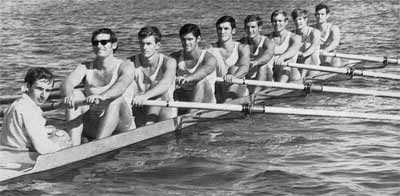
The first Sydney eight to win the Grand at Henley-on -the-Yarra
John Nickson (bow), Graeme Farrell, Guy Horsley, Gary Pearce, Kim Mackney, Joe Fazio, Michael Morgan, Alf Duval (stroke) and Alan Grover
The lightweight seniors were also very successful, the crew of Ian Carmody (bow), Allen, Tagg, Dennis Carmody (stroke) and Hollingworth (cox) romping away with the State championship event. At the end of the season, this crew, together with Phil Goldie, Andy Phillips, Alan Turner and Bob Powell, also secured the lightweight eight title. At the Henley-on-Yarra regatta in February, 1969, the club won the Grand Challenge eights and the lightweight senior eights, while Mackenzie won the Yarra Challenge Cup and Silver Sculls (beating Edwards in the final). Other good wins in the year included the success of Bob Allen in the Walker and Hall sculling series, of Michael Phillips in the champion junior sculls, rowed at Grafton, and the win in the Riverview Gold Cup by the crew of Hartman (bow), May, Hyslop, Farrell, Horsley, Dickson, Nickson, Letch (stroke) and Chessell (cox).
NSW supporters approached the 1969 King's Cup with justifiable optimism. The State selectors were Cec Pearce and Maurie Grace together with Phil Cayzer and Bob Stone, the two successful coaches. Two changes were made to the eight which had won the championship, Shirlaw, who had won the sculling title, and Clarke gaining seats at the expense of Nickson (emergency) and Horsley. The lightweight four remained in tact, with Powell emergency, while Mackenzie, runner-up to Shirlaw, was named NSW sculler.
It was Queensland's turn to stage the King's Cup in 1969 - the 50th anniversary of the AIF crew's success-and Bundaberg was chosen as the site for the first time ever. Despite their six Olympians, the NSW eight was beaten in the final of the King's Cup by Victoria. The Vics, with Douglas, Ramage and Guest all present, led from start to finish and won by a length with SA 4 lengths back third.
The lightweight four won the final, but only after being disqualified in the heat and entering the final through a win in the repechage. They defeated Tasmania narrowly with SA third. A new sculling champion emerged in Reg Free of Tasmania, who defeated Sykes and Kert with Mackenzie a disappointing fourth.
The final season of the decade - and of Sydney Rowing Club's first 100 years-showed promise of considerable interest. A visit by a NZ squad was scheduled for late in the second half, there were to be the Australian National Championships and the well-planned Sydney Centenary Regatta itself and, finally, a large squad was likely to be sent to the Third World Championships to be staged in Canada in September, 1970.
One Australian only - Reg Free, the national sculling titleholder - visited Klagenfurt, Austria, in September, 1969 for the European championships. Despite fracturing a little finger in training and other bad luck, he missed a place in the final by 1 second only.
Alf Duval was amongst a number of retirements at the start of the season. Nevertheless, Sydney's seniors and lightweight seniors scored a series of wins. At the championship regatta in December, Sydney won the champion coxed fours and also the champion junior fours, while Morgan and Pearce finished second in the coxless pairs.
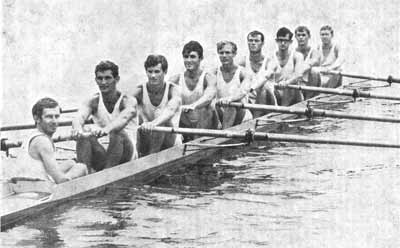
1970 NSW Champion Eight
The champion eights of NSW were rowed early in February, 1970 and, in its 100th year, Sydney won the title once again. The race was a great one. A combined Mosman-Colleagues crew led early but a composite Universities crew took over with 500 metres to go. The University oarsmen looked set to take the title when Sydney staged a great finish to take the lead in the last 50 metres and win by a canvas. Mosman-Colleagues and composite Universities dead-heated for second. Sydney's crew was Letch (bow), Fiskerstrand, Horsley, Perkowicz, Nickson, Mackney, Morgan, Pearce (stroke) and Grover (cox). Haberfield beat Sydney by 1/2 length in the champion lightweight fours while Reddel won the sculls, the Sydney scullers Bennett, Mackenzie and Phillips finishing fourth, fifth and sixth. Sydney oarsmen also took part in the 1970 Henley-on-Yarra regatta and were successful in winning the Stewards' Fours.
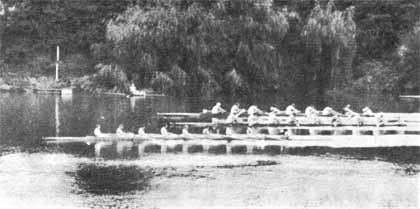
Sydney wins the champion eights of NSW in the centenary year of 1970
Pearce and Grace were chosen as State selectors in 1970 once again. Their King's Cup crew included five Sydney men-Perkowicz, Mackney, Morgan, Pearce and Grover-together with Freeman and Wilkinson of Haberfield, Stevens of Colleagues, and Allsop of University. Ian Carmody of Sydney was added to the Haberfield lightweight four, while Ian Chessell also gained selection as coxswain.
The big events were held on Lake Wendouree and were without success for NSW. The eights was a great battle between Victoria, SA and Tasmania with the strength of the Vics carrying them to a 1/2 length victory. NSW was fourth. Reg Free defended his President's Cup title well, with Reddel finishing third behind Talbot of SA. The Penrith Cup saw the lead see-saw between SA and NSW, with SA finally gaining a narrow victory. Victoria and WA deadheated for third.
There was still much excitement left in the 1969,/70 season. Sydney's oarsmen won three more championships - the lightweight eight, the junior eight and the lightweight coxless pair-to confirm another premiership win in the club's centenary year. Crews from NZ, the Philippines and five States competed in the Sydney Centenary Regatta on 2 and 3 May. There were many highlights: the presentation of the "Her Majesty The Queen's Plate" for women's fours by the Governor-General, Sir Paul Hasluck; the splendid 4 length win by NZ Colts in the senior eights; the eventful "relay" race between teams comprising a sculler, a pair, a four and an eight; and the wins to Sydney in the junior eights, lightweight senior eights and junior sculls.
A week later, the Australian National Championships were held on the Nepean. Sydney's best performance came from the lightweight eight which won the title narrowly from Mosman. The crew was boated L. Favaloro (bow), A. Favaloro, R. Tierney, J. Nicoll, I. Carmody, R. Tagg, A. Phillips, R. Allen (stroke) and V. Bowrey (cox). The junior eights was a thriller with Joondalup of WA beating Sydney by a few feet. Closer still was the specially-staged Bi-Centennial Eights in which NZ Colts defeated the winning Victorian King's Cup eight by 0.1 seconds.
The championships were, once again, selection trials for the World Championships and, after their conclusion, the AARC announced a squad of 21 to compete in Canada in September. The oarsmen comprised the Victorian eight and emergencies, an outstanding Corio Bay coxless pair and a Tasmanian coxed four including Reg Free, the sculling champion.
Other Developments
The decade was one of great significance in school rowing, with the long-held hopes of the high schools taking up rowing in a big way becoming a reality and the first Combined High Schools' Regatta being held. By the end of the decade, the GPS crews, even with their own boatsheds, top-class coaches and long training periods, were becoming significantly aware of the strength of the competition. The long-term prospects for NSW rowing from the additional activity at the school level were, of course, very encouraging. In GPS events, five schools were successful in the ten regattas held the decade. Shore won again in 1961, but it was to be their only win. St. Ignatius' was second - and King's third.
In 1962, Scots took the title by 1/2 length from Newington with Grammar well-up.
1963 was an important year for Newington, the school's 100th anniversary, and the rowers, under Tom Chessell's tuition, contributed by securing the coveted title. In 1964, Riverview, coached in the European style by Noel Hammond and Duncan Baggett, won by no less than 6 lengths. The following year, Scots experimented with new techniques as well and they scored a good win.
The 1966 event was a very exciting one, with Newington, coached by Ernie Chapman and rowing the orthodox style, beating Scots by 3 feet, with Shore and Grammar dead-heating for third 1/2 length further back. A change came over the scene, however, in 1967, with the arrival of Bob Buntine, former Melbourne oarsman and coach. His King's eight won by 1 1/2 lengths from Newington to give the school its first win for 46 years.
The following year his crew won again, this time by 2 1/2 lengths, and in 1969 he completed the hat trick (but by only a canvas from Newington). In the 1970 event, Buntine made it four in a row with a good win over Shore and St. Joseph's. A new move by the GPS authorities in 1968 was the introduction of a "second eights" events (for the "L.C. Robson Memorial Trophy"), the crews ranking immediately after the Head of the River crews. Newington was the first winner. The King's-Newington regatta, first staged in 1945, was discontinued after the 1966 contest. In 1967, however, Newington undertook the first of a series of "all-schools" regattas on the SRC course.
Commencement of the break-through in CHS rowing took place in 1962/63. In that year, Narwee High School took to the water, using the facilities of St. George Rowing Club. In 1963/64, largely due to the efforts of Sid Hawkes of Narwee, the CHS Amateur Athletic Association accepted rowing as an official sport. Special events for high school oarsmen were planned for the following season. Sydney co-operated by sponsoring Vaucluse High School, allowing their oarsmen to use the club's equipment.
The first CHS championships were held in April, 1965, in conjunction with the Metropolitan Regatta, and no less than 55 crews from 14 schools competed. The main race - in fours - was won by Lismore by 1/2 length from Narwee.
The 1965/66 championships had Sydney High emerging, amid some controversy as to their eligibility, as top school, with Richmond River second. The latter school later competed in the Australian schoolboy championships at the National Regatta in Ballarat.
At the 1966/67 regatta, 15 CHS schools competed in four events - the champion fours 1 and 2 and the champion pairs 1 and 2. There were five country schools-Grafton, Lismore, Richmond River, Taree and Telopea Park (ACT)-plus ten Sydney schools-Cleveland Street, Drummoyne, Forest, Homebush, Hunter's Hill, Ibrox Park, Narwee, North Sydney, Sydney and Vaucluse.
During this season, Homebush, coached by George Carlson, was permitted to train from SRC as well as Vaucluse, coached by Ernie Tucker. The main event went to Richmond River, from Lismore and North Sydney.
In the 1967/68 season, the CHS conducted a completely separate regatta and eight-oared rowing was introduced. There were, in all, five events: eights, 1st, 2nd and 3rd fours, and tub pairs. A shield for the eights was donated by Sydney Rowing Club and it was won in the first year by Telopea Park. The champion school in the eights in 1968/69 was Sydney High, while a newcomer, Manly High, took the fours.
At the 1969 Riverview Regatta, the latter crew graphically illustrated the standard being reached by the high schools by defeating its GPS rivals in the event for lst fours. This feat was repeated in 1970 by Homebush. The CHS regatta in 1970 was held at Grafton and Sydney High won the eights from Telopea Park and Homebush, while Grafton itself won the fours. By the end of 1968, the two schools at SRC, Vaucluse and Homebush, had both purchased a new regulation four of their own (with George Carlson back in the limelight by fitting poppets to the Homebush boat!).
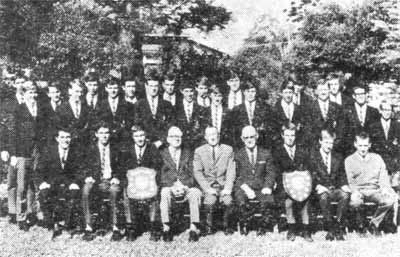
Homebush High's oarsmen in 1967
Women's rowing reached new heights in the years 1960-1970. By the end of the period, there were nine clubs affiliated with the NSW Women's Rowing Association, along with the Union of Ex-Oarswomen. The nine clubs were Sydney, Mosman, North Shore, Sydney University, Newcastle University, Nestle's, Richmond River, Griffith and Manning River. Sydney continued to develop, gradually improving its shed and with a fleet of three fours, two pairs and a scull in good order at the end of the period.
NSW was successful in eight of the ten interstate races conducted during the decade. The Victorian win in 1966 broke a sequence of eleven wins by NSW and the Vics won again in 1969. ACT and SA competed in the 1965 and 1966 events, but the starters were usually confined to NSW, Victoria and Queensland. An interstate sculling race was introduced in 1963 and a lightweight fours event (under 9 stone) in 1968. A visit from a NZ four was received in 1966 and again in 1970 while, at the end of the decade, there were sound prospects of women's rowing becoming an Olympic sport - perhaps as early as 1972.
An application by Australia to FISA to stage the World Rowing Championships was among the matters approved by the AARC during the decade. The occasion was the 1961 meeting, with the championships in view being those of 1970 (to celebrate the 200th anniversary of Captain Cook's voyage of discovery). The application was confirmed in 1964 but the 1966 AARC meeting reluctantly decided that the course in mind - Lake Burley Griffin - was not suitable for world championships, and the application was withdrawn.
The 1961 meeting also agreed at last to the holding of a National Regatta each second year, and to the conducting of the King's Cup events in heats, repechages and finals over a two-day period. Rule changes and financial problems were carefully examined in the decade. A new constitution was approved in July; 1964 with an AARC Racing Code also included.
The subject of a levy being placed on all oarsmen in Australia, the monies to be placed in an Olympic Games Appeal Fund, was raised at the 1963 meeting, but unanimity on the matter could not be obtained. Renewed efforts to tackle the international tour finance problem were made in 1967 when, at the suggestion of the NSWRA, the first of a series of annual meetings of Association treasurers was held just prior to the regular AARC meeting. Useful discussions, especially on organising a capital fund, took place and the AARC later approved the raising of a fund through the contributing by the States to the AARC of 50 per cent of the profit on each King's Cup Regatta. By April, 1969, $423 was in hand and it was decided to reinvest the interest on the funds and to make no withdrawals until the sum of $20,000 had been reached.
Other matters of interest were the setting up of an Equipment Sub-Committee in 1965; the concern as to the future of Empire Games rowing in 1966; approval to the regular rotation of the National Regatta among States in 1968 (although no State was obliged to conduct it); and the continuing strong encouragement to the inclusion of lightweight events in Olympic Games and World Championships. (Efforts to have sales tax on sporting equipment removed also continued as a hardy annual.)
The NSW delegate to the AARC throughout the decade was Sir Harold Alderson, and he was the Council's President in 1963/64 and 1969/70. Sir Harold and Reg Blundstone, the hon. secretary/treasurer from Tasmania who was re-elected each year, were also regularly elected by the Council to be delegates to the Australian Olympic Federation and the Australian British Empire and Commonwealth Games Association. The efforts of Jim Rogers, as Australia's representative to FISA, and Max Berge-Phillips, as the AARC's London representative, were much valued during the decade.
There were some important developments within the NSWRA. In 1960/61, provision was made for the appointment of a panel to examine boat race officials and issue a four-year period of qualification to successful candidates. From 1962/63, the newly-formed Union of Boat Race Officials elected two delegates to the RA's committee itself as a separate body.
In 1964/65, a sub-committee to inspect courses was set up and it found, unfortunately, that all courses were incorrectly marked. As a result, extensive resurveying was undertaken and a "Clerk of Courses" was added to the list of officers, his duty being to see that all survey marks were adequately maintained.
A Safety Committee was formed in 1966/67, following a number of nasty accidents on the river. A "Safety Officer" was appointed the following year, while schemes for the insurance of oarsmen on the water were also examined.
New rules were formulated by a special sub-committee and approved in October, 1969. They included the establishment of a Management Committee for the RA which was to comprise the chairman, deputy chairman, treasurer, secretary, assistant secretary and four members. The point-scoring system continued to be examined at intervals during the decade and a change was finally introduced in 1969/70: a third point-score competition-for senior events only-was added to the junior pennant and the premiership.
Financial problems continued to give concern. Just over $200 was added to the International Fund (which had stood at $3500) in 1960/61, but, apart from interest, this was the only addition in the decade. Some $740 was utilized in 1961/62, while the expenses incurred in the Canada - Europe tour in 1967 virtually finished the fund off. In 1964/65, a Finance Committee was established, made up of the treasurers of the Association and the various clubs, designed especially to resolve problems of the financing of interstate representation. A scheme of subsidising such costs by the clubs was soon introduced (the Melbourne Cup sweep being discontinued). Losses on boat sales aggravated the situation and the amount outstanding to sundry creditors had reached a disturbing level towards the end of the decade.
The Association's annual ball was held throughout, the period and, on most occasions, was a resounding success adding, in addition, to the Association's funds. The RA also continued to gain solid support from the NSW Union of Old Oarsmen. The Union held a regular series of functions each year, including a "Welcome Home" to each batch of State representatives, and was a generous donor to the RA's funds. In the early part of the decade, especially, the Union gave every assistance in the abortive attempt to establish a "Rowers' Club" to be a source of finance for the future.
Mr. Justice Maxwell continued to serve as RA president throughout the decade, although unable to play an active part in its activities. Sir Harry Alderson also continued to act as chairman, a position he first held in 1921/22. In the position of honorary secretary were Roy Hunt, Bill Purcell, Ross Selman and Maurie Grace. Laurie Stepto retired as treasurer in 1966/67 to become, following the death of John Rook and the ill-health of Alan Callaway, deputy chairman of the Association. Ian McIntyre, Clive Partridge and Bill Winkworth succeeded him. By the end of the period, Norman Barrell had been an RA auditor for almost twenty years and G. A. Mackisack for ten years.
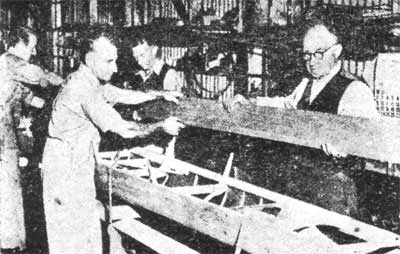
George Towns supervising boatbuilding work
The past glories of professional sculling were being recalled at the end of the decade. The Union of Old Oarsmen, with the help of funds held by the trustees of the old NSW Professional Sculling League, undertook the construction of a memorial to George Towns, who died in 1961, aged 92. The memorial, a judges stand, was erected at the finishing line on the SRC grounds and was unveiled during the Centenary Regatta.
And so the first hundred years of Sydney Rowing Club - 1870 to 1970 - drew to a conclusion, with the club and the sport of rowing in NSW and Australia in a flourishing condition. So many fine men over such a long period of time would be proud of the achievements of the century and delighted by the prospects which are still in store.
